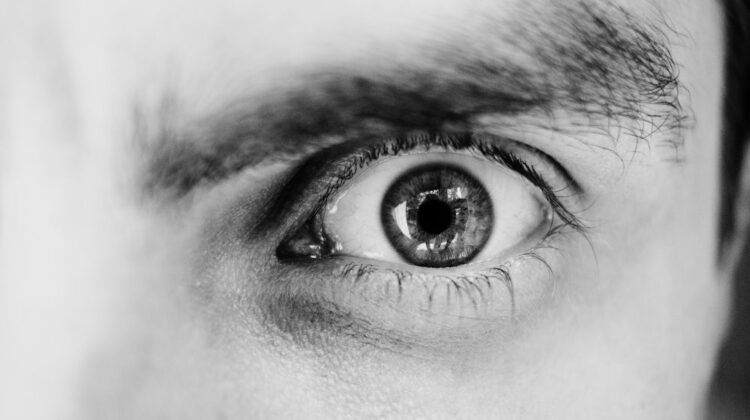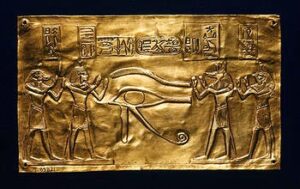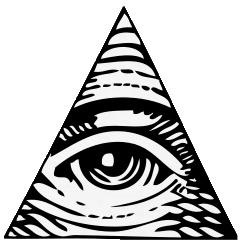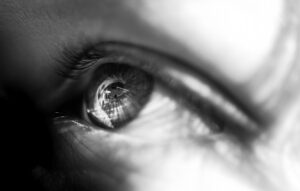
It is often stated that modern society is overly focused on the visual. But is this true and why is it even important? And when it really comes down to it, aren’t we mainly just visual beings or are we missing something here?
We hear it again and again, sentences like: “We are visual creatures,” “Vision takes up 70 % of our brain power” or even “the eyes are the doors to the soul.”
As professional sound enthusiasts, this can seem disparaging or even a little annoying. But is it really that simple? We seem to live in a visually dominant time and culture, but how did this come about and what does it mean for our behavior and our environment?
Ever since Greek antiquity, prominent thinkers have repeated the same litany about vision. As an example, Plato regarded the eyes as the entrance point of divine inspiration and enthusiasm.[1] The eye were according to Plato created with a special ingenuity and lavishness not to mention that he, for good measure, proclaimed that the eyes had an inherent theological essence and were directly related to the holy sun. [2]
This trend in how the senses are valued can be traced directly through a line of the most referenced and revered thinkers through western history. Here is a list of examples:
- Aristoteles[3]
- Gaius Julius Cæsar[4]
- St. Augustine[5]
- Thomas Aquinas[6]
- Galileo Galilei[7]
- René Descartes[8]
- Goethe[9]
- Immanuel Kant[10]
- Hans Jonas[11]

This privileging of sight through history is also called ‘ocularcentrism’ and has arguably created and upheld a strong visual focus in the western world that can be argued to have far reaching effects on society at large.
Cultures that are highly focused on the sense of sight might for example be easily infatuated with superficial beauty or have a collective tendency for pursuing the spectacular.
It is however quite easy to demonstrate how this visual focus has affected our everyday vocabulary. Most western languages are filled with visual metaphors like:
- ‘Seeing’ is believing.
- These are valuable ‘insights.’
- Do you ‘see’ what I mean?
- She is a very ‘reflective’ thinker.
- In my ‘view,’ that is right.
- He is a ‘visionary.’
- Here are some ‘observations’.
- I’ll have a ‘look’ at it.
As these examples illustrate our sense of sight is often equated with knowledge in our daily use of words. Even the word ‘theory’ is derived from the Greek word for theater, ‘tereotria’ which literally means ‘to behold.’ But are these clear sign of visual focus in our language even important?
Well according to Nietzsche[12] the principal danger of metaphors is that you confuse the transferred comparison of the metaphor with the actual object the metaphor is being used to explain. In other words, this is roughly the verbal equivalent of the proverb: “If all you have is hammer, everything looks like a nail.” – If you for example equate knowledge to your sense of sight, the characteristics of your visual faculties can influence the very way you think and learn. What this actually means can be hard to conceptualize without thinking a bit about sensory phenomenology. That is to say, the characteristics of how we experience our surroundings through the senses. So let’s consider some typical examples of the phenomenology of sight and hearing:
Our eyes are basically always focusing on a very small point. They are directional and constantly discriminating what is of highest interest and value. The visual faculties objectify the world by dividing it into objects and objectives; in other words, stuff and utility. Objects we perceive with our sense of sight seems static and we perceive a sense of surface and exterior from a distance.
Our ears are omnidirectional and includes all audible signals at once even around obstacles. Hearing thereby give us the sense of being immersed in our environment.
Murray Schafer said that “hearing is a way of touching at a distance.” Turns out our hearing literally is an evolution of our sense of touch[13]; which connotes a feeling of closeness and intimacy.
Sound signifies an action so our aural sense is more oriented on something happening or changing. Sounds also reveal materiality and density as we can understand mass and interior through vibrations (x).
So which metaphor is the best for conceptualizing the world and our place in it? It can be hard to even imagine what difference it would make, but there do actually exist cultures that place their sense of hearing above sight in their “sensory hierarchy.” The native Brazilian Suyá tribe considers the sense of sight to be treacherous and anti-social. Because of this they perform their rituals at night, when sight is dulled and the other senses becomes sharper.[14] Similarly the Kaluli tribe in Bosavi of Papua New Guinea, places more trust and value in their sense of hearing.[15] So we can conclude that a cultural visual focus doesn’t seem to necessarily be the default of human social structures.
By Morten Roar Berg & Lauren Clark
- This post is not a traditional Acoustic Bulletin post. Please let us know if you like this style of writing and content, if you like to see more traditional posts or perhaps something different?
- The above information is gathered by a wide range of literature of which not all is directly cited. Beyond the ordered references please also see the list of additional sources.
Read the following posts in the series “Our Visual Focus” here:
Our Visual Focus (part 2) – The Eye vs. the Ear
Our Visual Focus (part 3) – Deafly Designed
Ordered Sources
[1] Kambaskovic, Danijela & Wolfe, Charles T. (2014): ”The Senses in Philosophy and Science: From the nobility of sight to the materialism of touch,” University of Western Australia & University of Ghent, Australia. p. 1
[2] Platon (1991): ”The Republic of Plato.” Second Edition, Translated by Allan Bloom, Harper-Collins Publishers, New York, USA. v. 508d
[3] Aristoteles (2012) “The Metaphysics.” Første udgave, oversat af Ross, W. D., CreateSpace Independent Publishing, North Charleston, South Carolina, USA. Book 1, p.1
[4] Howes, D. & Classen, C. (1991): “Conclusion – Sounding Sensory Profiles” in ”The Varieties of Sensory Experience – A Sourcebook in Anthropology of the Senses.” University of Toronto Press, Ontario, Canada. p. 257
[5] Nash, Ronald H (1969): “The Light of the Mind – St. Augustine’s Theory of Knowledge.” Lexington: University Press of Kentucky, Kentucky, USA.
[6] Unspecified (1920): “The Summa Theologiae of Thomas Aquinas.” Litteral translattion by Fathers of the English Dominican Province, second revised edition, Online Version: http://www.newadvent.org/summa/index.html, Part 1 of Part 2, Question 3, Article 8
[7] Galileo, Galilei (1957): “The Assayer.” Oversat af Stillman Drake, in “Discoveries and Opinions of Galileo”, abreviated edition, Standford University, Stanford, Californien, USA. pp. 24-25
[8] Judovitz, Dalia (1993): “Vision, Representation and Technology in Descartes.” I Levin (1993). p. 71
[9] Goethe, J.W. (1970): “Theory of Colors.” Oversat af C.L. Eastlake, Cambridge, Mass.: MIT Press, Massachusetts, USA.
[10] Kant, Immanuel (1798): “Anthropology from a Pragmatic Point of View.” Translated by Victor Lyle Dowdwell 1996, Southern Illinois University Press, Illinois, USA.
[11] Jonas, Hans (1966): “The Nobility of Sight – A Study in the Phenomenology of the Senses.” Philosophy and Phenomenological Research, Vol. 14, No. 4, International Phenomenological Society, Wiley Online Library. p. 513
[12] Nietzsche, Freidrich (2000): “On Truth and Lie in an Extra-Moral Sense”, i Cazeaux, C., The Continental Aesthetics Reader, Routledge LTD, London, England. p. 58
[13] Raghunandhan, S et al. (2016): “The Evolution of Hearing from Fishes to Homo sapiens – A Chronological Review.” Madras ENT Research Foundation, Scholars Academic Journal of Biosciencesm, ISSN 2321-6883.
[14] Stoller, Paul (1997): “Sensuous Scholarship.” University of Pensylvania Press, Pensylvania, USA.
[15] Feld, Steven (2012): ”Sound and Sentiment – Birds, Weeping, Poetics and Song in Kaluli Expression,” Third Edition, Duke University Press, Durham, England.
(x) Phenomenology is by definition not an exact science and other descriptions of sensory experience has also been presented, but the descriptions presented above could well be argued as being the consensus.
Additional Sources:
Åhlberg, Lars-Olof (1996): “Modernity and Ocularcentrism – A Second Look at Descartes and Heidigger.” Filosofski Vestnik, XVII, Open Humanities Press. pp. 10-11
Jay, Martin (1988) “Scopic Regimes of Modernity.” Vision and Visuality, Bay Press, 3-23, ISBN: 1565844610.
Jay, Martin (1988): “The Rise of Hermeneutics and the Crisis of Ocularcentrism.” Poetics today, Vol. 9. No. 2.: The Rhetoric of Interpretation and the Interpretation of Rhetoric, Duke University Press, pp 307-326.
Jay, Martin (1991): “The Disenchantment of the Eye – Surrealism and the Crisis of Ocularcentrism.” Visual Anthropology Review, Volume 7, number 1.
Kavanagh, Donncha (2004): “Ocularcentrism and its Others – A Framework for Metatheoretical Analysis.” Organization Studies, 25 (3), Sage Publications, pp. 445-464.
Benjamin, Roy (2015): “Looking for the Bilder – the Subversion of Ocularcentrism in Finnegans Wake.” Borough of Manhatten Community College, Journal of Modern Literature, Volume, 38, Nummer 2, New York, USA.
Levin, David M.K. (1989): “Listening Self – Personal Growth, Social Change and the Closure of Metaphysics.” Routledge, London, England.
Kavanagh, Donncha (2004): ”Ocularcentrism and its Others: A Framework for Metatheoretical Analysis.” Department of Manegement & Marketing, National Univeristy of Ireland, Sage Publications, Cork, Ireland.
Ritzer, George (1990): “Metatheorizing in Sociology.” Sociological Forum, Vol. 5, No. 1, Kluwer Academic Publishers/Plenum Publishers, Norwell, Massachusetts, USA.
Pallasmaa, Juhani (2005): “Eyes of the Skin – Architecture and the Senses,” Første Udgave, John Wiley & Sons Ltd, West Sussex, England.



